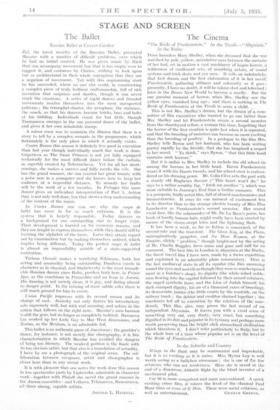STAGE AND SCREEN
The Ballet
Russian Ballet at Covent Garden Bed, the latest novelty of the Russian Ballet, presented Massine with a number of difficult problems, over which
he had no initial control. He was given music by llicti that can accompany movement but that is too empty ever to suggest it, and costumes by Chirico, striking to look upon but so architectural in their whole conception that they are a negation of movement. Yet with this unpromising start he has succeeded, where no one else could, in constructing
a. complex piece of truly brilliant craftsmanship, full of rich invention that surprises and dazzles, though it can never reach the emotions. A series of rapid dances and frenzied movements resolve themselves into the most unexpected patterns ; the triumphal chariot, the aeroplane, 'the staircase, the couch, so that his dancers become bricks, bars and bolts at his bidding.. Individuals count for but little, though Toumanova emerges in the one personal dance of the ballet, and gives it her own inimitable stamp.
• A minor error was to maintain the illusion that there is a story to tell by a complex scenario in the programme, which fortunately is the only place in which it actually exists.
. Conies Busses this season is definitely less good in execution than last year though, individually much fine work is done. Grigorieva as The Swan Princess is not yet fully equipped technically for the most difficult dance before the curtain, so superbly created by Tchernicheva. Yet for all her short- comings, she makes a success and fully merits the role. She has the grand manner, she can control her great beauty with a poise rare in a youngster and she knows how to keep her audience at a respectful distance. To remedy her faults will be the work of a few months. In Presages this same dancer gives an individual interpretation of Part 1. Action that is not only well done, but that shows a deep understanding of the content of the music.
In Conks Busses one can see, why . the corps de ballet has come in for so much criticism. It is the system that is largely responsible. Today dancers as a background for one outstanding star no longer exist. Their development is hurried on for economic reasons, and they are taught to express themselves, while they should still be learning the alphabet of the barre. Later they attain regard not by examination but by making themselves noticed, which implies being different. Today the perfect corps dc ballet is almost an 'impossibility outside of a state-supported institution.
Tatiana Charnie makes a terrifying Kikimora, both her acting and musicality being outstanding, Danilova excels in character as in classical, and Shabelevsky is the most remark- able Russian dancer since Bohn, peerless both here, in Prin'ie Igor, as the coachman in Petrouchka and an Ivan in Aurora. His (lancing is not merely clean, it is gay, and daring almost to danger point. In the miming of more subtle roles there is still much ground for him to cover.
Union Pacific improves with its second season and its change of cast. Jasinaky not only dances his introductory solo gupreMely well, but with real meaning, and ushers in the action that follows on the right note. Massine's own barman is still the gem, but no longer so completely isolated. Baronova has worked up her Lady Gay to Mae West dimensions, and Zorina, as the Mexican, is an admirable foil.
This ballet is an authentic piece of Americana; the gambler's dance, for instance, is not merely fine choregraphy, it is fine characterization in which Massine has avoided the dangers of being too literary. The weakest portion is the finale with its too obvious satire, but that also is a translation of actuality. I have by me a photograph of the original scene. The col- laboration between composer, artist and choregrapher is closer here than in any recent work.
It is with pleasure that one notes the work done this season in less spectacular parts by Lipkovska, admirable, in character work—together with Platoff she saved the grand.- manner in the Aurora ensembles—and Volkova, Tchinarova, Razounrova, all three strong, capable artists.
ARNOLD L. HASKELL.














































 Previous page
Previous page